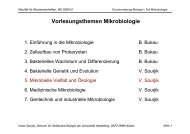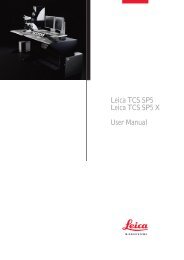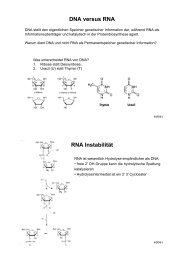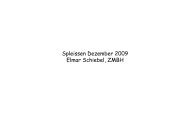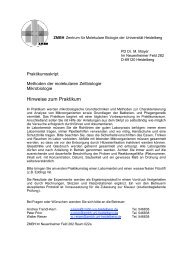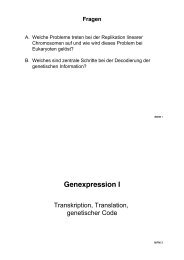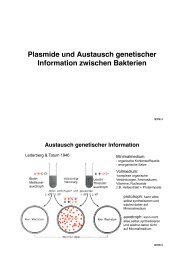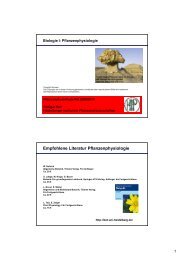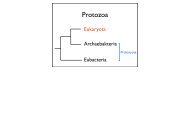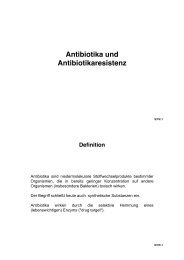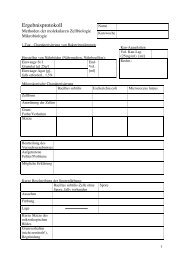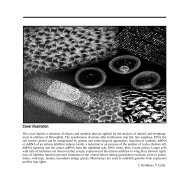ZMBH J.Bericht 2000 - Zentrum für Molekulare Biologie der ...
ZMBH J.Bericht 2000 - Zentrum für Molekulare Biologie der ...
ZMBH J.Bericht 2000 - Zentrum für Molekulare Biologie der ...
You also want an ePaper? Increase the reach of your titles
YUMPU automatically turns print PDFs into web optimized ePapers that Google loves.
ing the disease. To study the influence of cholesterol<br />
on APP metabolism we collaborated with M. Simons,<br />
K. Simons and C.G. Dotti (EMBL) and used primary<br />
cultures of rat hippocampal neurons infected with<br />
recombinant Semliki Forest virus carrying APP and<br />
APP mutants. This system has been used previously<br />
by us to study the intracellular transport and processing<br />
of human APP. Inhibition of cholesterol biosynthesis<br />
and extraction of cholesterol from neuronal membranes<br />
was achieved by a combination of statin treatment<br />
and methyl-ß-cyclodextrin extraction. Statins<br />
such as lovastatin or simvastatin allow in the presence<br />
of low amounts of mevalonate the control of the synthesis<br />
of cholesterol by inhibiting 3-hydroxy-3-methylglutaryl-CoA<br />
(HMG-CoA) reductase. Mevalonate is<br />
required for the synthesis of non-steroidal products<br />
and essential to prevent inhibition of the proteasome<br />
by lovastatin. ß-Cyclodextrin has been shown to very<br />
efficiently and selectively extract cholesterol from the<br />
plasma membrane.<br />
The combined treatment of rat hippocampal neurons<br />
with statins and methyl-ß-cyclodextrin resulted in<br />
reduced intracellular Aß production and Aß secretion<br />
(Fig. 3), however APP levels and cell viability<br />
remained unaffected in both treated and control cells<br />
during the time course of the experiments.<br />
Since Aß generation occurs in two steps, we employed<br />
the two APP constructs APP695 and A4CT (SPC99)<br />
to analyze which Aß cleavage is inhibited by cholesterol<br />
lowering drugs. The first cleavage of APP by<br />
ß-secretase generates the 10-kDa fragment C99 that is<br />
further cleaved within the transmembrane domain by<br />
γ-secretase to produce Aß. When antibodies recognizing<br />
the C-terminal domain of APP were used to immunoprecipitate<br />
APP fragments from the cell lysates of<br />
cholesterol-depleted and control rat hippocampal neurons<br />
expressing human APP695 a dramatic inhibition<br />
30<br />
of ß-cleavage was detected while the production of the<br />
fragment generated by α-secretase was unperturbed.<br />
To analyze the effect of lovastatin treatment on the<br />
cleavage of γ-secretase, neurons expressing SPC99<br />
were used since removal of the transient signal<br />
sequence of SPC99 generates C99 which is identical<br />
with the C-terminal ß-secretase product of APP. Conversion<br />
of C99 to Aß requires γ-secretase. Both lovastatin<br />
treatment and methyl-ß-cyclodextrin treatment<br />
- alone and together - of neurons expressing SPC99<br />
inhibited Aß production as well suggesting that cholesterol-lowering<br />
regiments inhibit also γ-secretase<br />
cleavage. Thus our combined results suggest that cholesterol<br />
is required for APP cleavage by ß-secretase<br />
and γ-secretase but not for α-cleavage that produces<br />
αAPPsec. We conclude that lowering of cholesterol<br />
affects amyloidogenic processing of APP while allowing<br />
nonamyloidogenic cleavage to proceed.<br />
These findings raise the question how cholesterol<br />
affects Aß formation. One possibility is that reduc-<br />
Figure 3: Cholesterol-lowering of hippocampal neurons<br />
reduces intracellular (lysate) production and secretion<br />
(media) of Aß40 and Aß2. Neurons were grown for 4 days<br />
in the presence of lovastatin/mevalonate and after infection<br />
with Semliki Forest virus/APP-expression vectors were<br />
treated with 5mM methyl-ß-cyclodextrin for 20 min.<br />
tion in membrane cholesterol changes the intracellular<br />
transport of APP so that the protein does not reach the<br />
cellular sites where ß- and γ-secretase cleavage takes<br />
place. If this is the case, cholesterol is required as a<br />
sorting platform for inclusion of APP protein cargo<br />
destined for delivery to the apical membrane in nonneuronal<br />
cells and to the axonal membrane in neurons.<br />
Alternatively, the ß- and γ-secretase require cholesterol<br />
for their activity.<br />
VII. Aß as biological marker of Alzheimer’s<br />
disease<br />
A. Diehlmann, T. Hartmann, N. Ida<br />
All mutations known to cause familial Alzheimer‘s<br />
disease act by increasing the levels of soluble ß-amyloid<br />
peptide, especially the longer form, Aß42. However,<br />
in vivo elevation of soluble Aß in sporadic<br />
Alzheimer‘s disease has so far not been shown. In collaboration<br />
with M. Jensen and L. Lannfelt (Karolinska),<br />
we used our monoclonal antibodies specific for<br />
Aß40 and Aß42 in an enzyme-linked immunosorbent<br />
assay to investigate cerebrospinal fluid from sporadic<br />
Alzheimer‘s disease at different stages of disease<br />
severity, to clarify the roles of Aß42 and Aß40 during<br />
disease progression. We also evaluated three other<br />
groups, one group of patients with mild cognitive<br />
impairment who were at risk of developing dementia,<br />
a cognitively intact, nondemented reference group<br />
diagnosed with depression, and a perfectly healthy<br />
control group. We found that Aß42 is strongly elevated<br />
in early and mid stages of AD, and thereafter<br />
it declines with disease progression. On the contrary,<br />
Aß40 levels were decreased in early and mid stages<br />
of AD. The group of cognitively impaired patients<br />
and the depression reference group had significantly<br />
higher levels of Aß42 than the healthy control group,<br />
implying that Aß42 is increased not only in AD, but<br />
in other central nervous system conditions as well.<br />
Our data also point out the importance of having thoroughly<br />
examined control material. The initial increase<br />
and subsequent decrease of Aß42 adds a new biochemical<br />
tool to follow the progression of AD and<br />
might be important in the monitoring of therapeutics.<br />
Acknowledgements: We acknowledge the stimulating<br />
and productive collaboration with among others<br />
the group of Gerd Multhaup (<strong>ZMBH</strong>), Colin L. Masters<br />
(The University of Melbourne, Australia), Renato<br />
Paro (<strong>ZMBH</strong>), Kai Simons and Carlos G. Dotti<br />
(EMBL), Thomas A. Bayer (Psychiatry, University of<br />
Bonn, Germany), Michael Hennerici and Klaus Fassben<strong>der</strong><br />
(Neurology, University Heidelberg at Mann–<br />
heim), Lars Lannfelt (Karolinska Institute, Stockholm,<br />
Sweden); Joachim Schrö<strong>der</strong> (Psychiatry, University<br />
Heidelberg), Bart De Strooper (University Leuven,<br />
Belgium), Rudolph E. Tanzi and Ashley I. Bush<br />
(Harvard University, Cambridge, USA), Hans Peter<br />
Schmidt (Neuropathology, University Heidelberg),<br />
Hans Förstl (Psychiatry, TU Munich, Germany) and<br />
Christian Haass (Biochemistry, University Munich).<br />
External Funding<br />
Our research summarized in this report would not<br />
have been possible without the following grants: an<br />
institutional grant of the Minister for Science and Arts<br />
of the State of Baden-Württemberg, by grants and project<br />
grants of the Deutsche Forschungsgemeinschaft,<br />
of the Landes Forschungsschwerpunktprogramm of<br />
Baden-Württemberg, the European Community, of the<br />
German-Israelic-Foundation, of the Humboldt-Foundation,<br />
of the Fonds of the Chemical Industry of Germany<br />
and by generous donations.<br />
31




